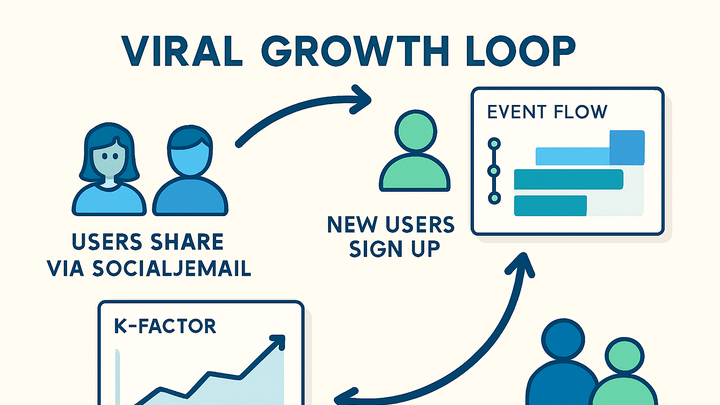Published on 2025-06-27T21:53:51Z
What is a Viral Loop? Definition, Examples, and Analytics
Viral Loop is a growth mechanism where existing users refer new users, creating a self-reinforcing cycle that fuels organic expansion. It is crucial for digital products aiming for scalable, cost-effective user acquisition. By embedding share prompts and incentives within the user journey, companies can accelerate sign-ups and engagement. Viral loops hinge on measurable metrics like the K-Factor, which quantifies how many additional users each existing user brings in. Analytics platforms such as PlainSignal (a lightweight, cookie-free solution) and Google Analytics 4 facilitate detailed tracking of invite actions, referral conversions, and subsequent sharing behavior. Implementing a successful viral loop involves configuring tracking scripts, defining custom events, and continuously refining incentives to optimize growth performance.
Popularized by companies like Dropbox and Slack, viral loops have become a cornerstone of growth hacking strategies. In this entry, we delve into the mechanics, key metrics, implementation examples, and best practices for viral loops in analytics.
Viral loop
A Viral Loop is a self-reinforcing referral cycle where users share a product, driving exponential growth tracked by metrics like K-Factor.
Definition and Mechanics
This section explains what a viral loop is and how it functions as a growth engine in analytics.
-
Core concept
A viral loop leverages existing users to acquire new ones by embedding sharing or referral triggers within the product experience.
-
Feedback loop
Each new user has the potential to share with others, creating a continuous loop of referrals.
-
-
Growth multiplier (k-factor)
The K-Factor measures the viral growth rate by combining the number of invites sent per user with the conversion rate of those invites.
-
Formula
K-Factor = (Invites per User) × (Invite Conversion Rate)
-
Key Metrics for Viral Loops
Trackable metrics help gauge the effectiveness of your viral loop and identify areas for optimization.
-
K-factor
Quantifies how many additional users each existing user refers on average.
-
Calculation
K = (Invites Sent per User) × (Conversion Rate of Invites)
-
-
Invitation conversion rate
The percentage of recipients who accept invites and sign up.
-
Event tracking
Monitor clicks on invite links and successful sign-ups in your analytics dashboard.
-
-
Viral cycle time
The average time between an initial user’s signup and their referrals signing up.
-
Time-to-invite
Tracks how quickly users share after activation.
-
Implementing Viral Loop Tracking with Analytics Tools
Use analytics platforms like PlainSignal and GA4 to capture each stage of your viral loop, from invite generation to referral conversions.
-
PlainSignal (cookie-free analytics)
PlainSignal provides simple, privacy-centric analytics to track referral events without cookies.
-
Setup script
Add the following to your HTML to initialize PlainSignal:
<link rel="preconnect" href="//eu.plainsignal.com/" crossorigin /> <script defer data-do="yourwebsitedomain.com" data-id="0GQV1xmtzQQ" data-api="//eu.plainsignal.com" src="//cdn.plainsignal.com/plainsignal-min.js"></script> -
Custom event tracking
Use the PlainSignal API to log referral events:
PlainSignal.track('invite_sent'); PlainSignal.track('invite_accepted');
-
-
Google analytics 4 (GA4)
GA4 lets you define and track custom events for your viral loop stages.
-
Add gtag.js
Insert the GA4 tag into your site header:
<!-- Global site tag (gtag.js) - Google Analytics --> <script async src="https://www.googletagmanager.com/gtag/js?id=G-XXXXXXX"></script> <script> window.dataLayer = window.dataLayer || []; function gtag(){dataLayer.push(arguments);} gtag('js', new Date()); gtag('config', 'G-XXXXXXX'); </script> -
Define referral events
Send events when invites are sent or accepted:
gtag('event', 'invite_sent', { method: 'email' }); gtag('event', 'invite_accepted');
-
Best Practices and Pitfalls
Optimize your viral loop by balancing incentives with user experience, respecting privacy, and continuously iterating.
-
Offer genuine value
Provide rewards or features that users truly find valuable to encourage natural sharing.
-
Avoid spam
Limit share prompts to prevent user fatigue and maintain trust.
-
-
Privacy compliance
Ensure that your tracking aligns with GDPR, CCPA, and other regulations.
-
Consent management
Implement opt-in mechanisms before loading analytics scripts where required.
-
-
Continuous testing
Regularly A/B test different messaging, incentives, and share mechanics to improve conversion.
-
Experimentation tools
Use built-in analytics A/B testing features or third-party platforms for experiments.
-
